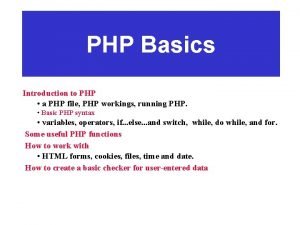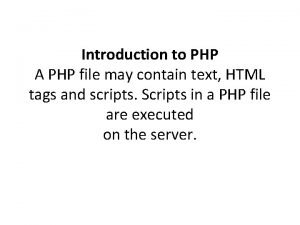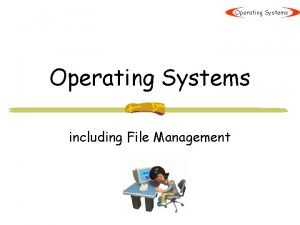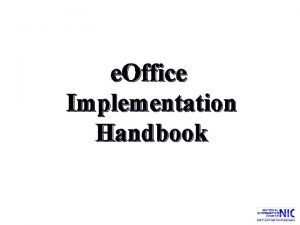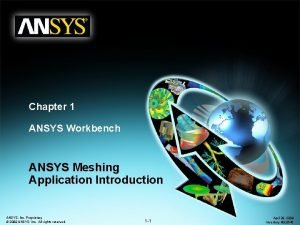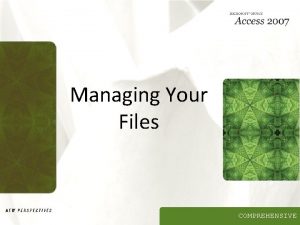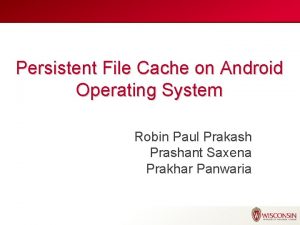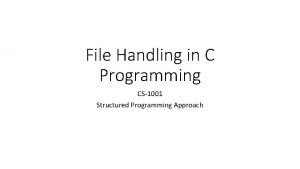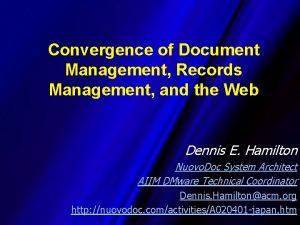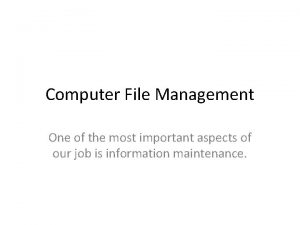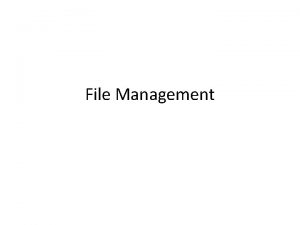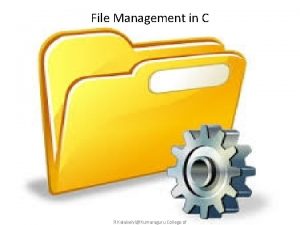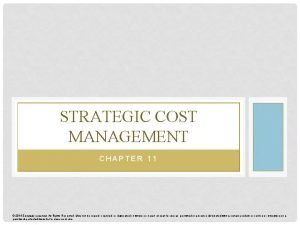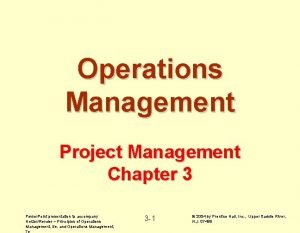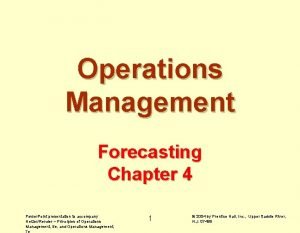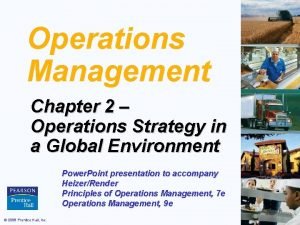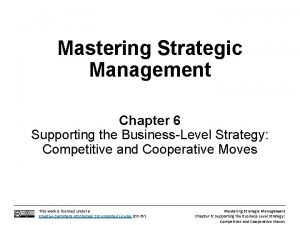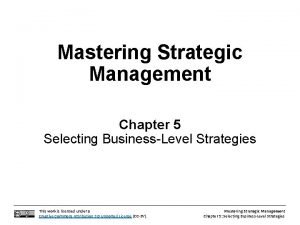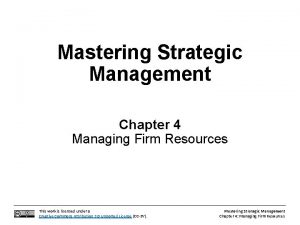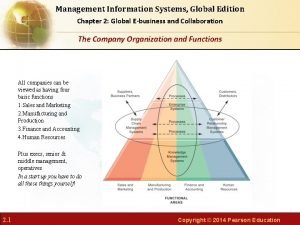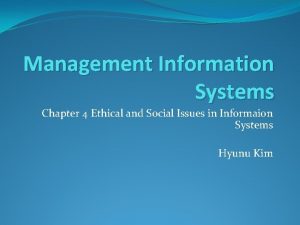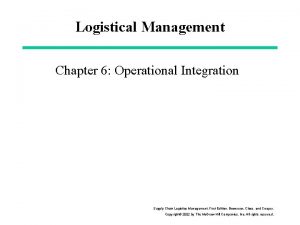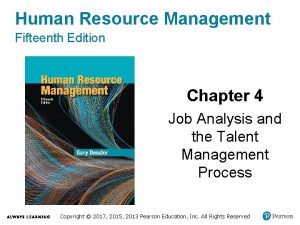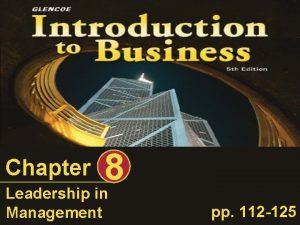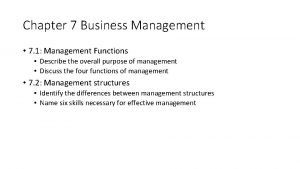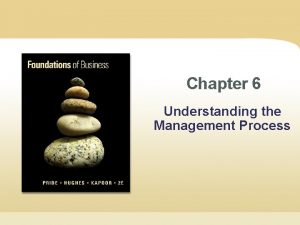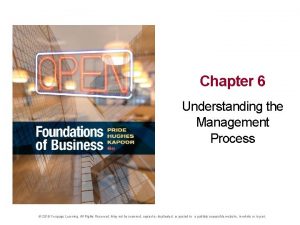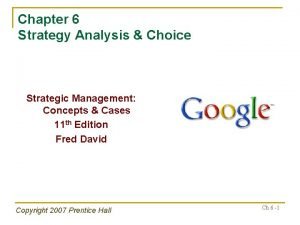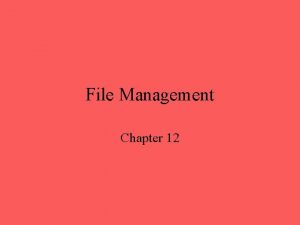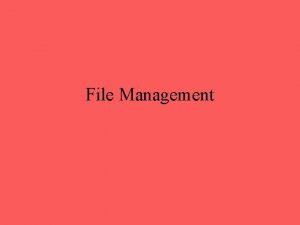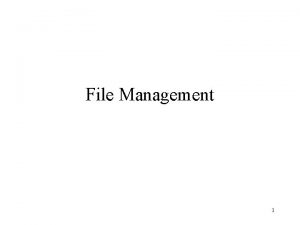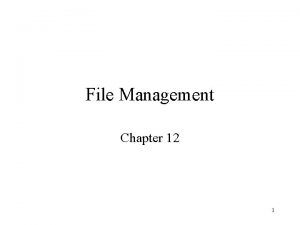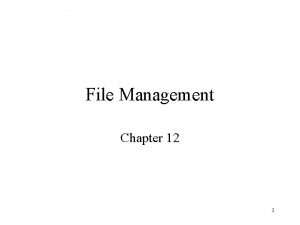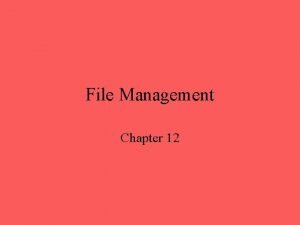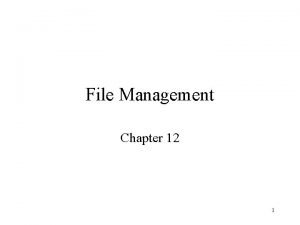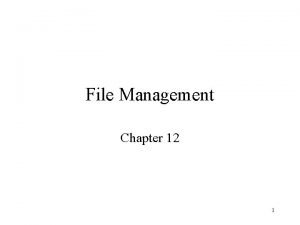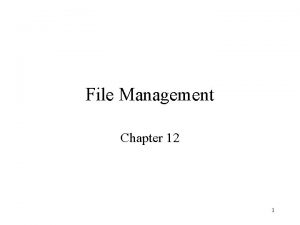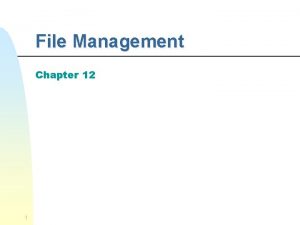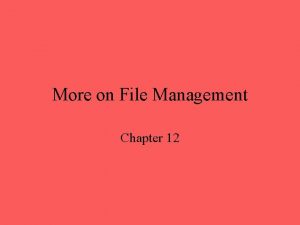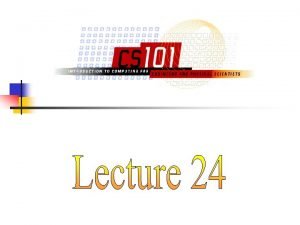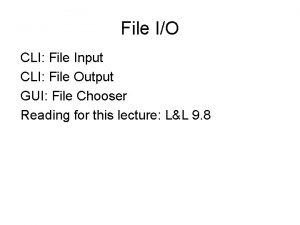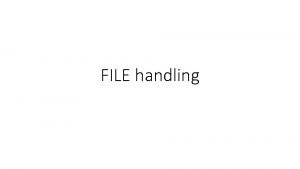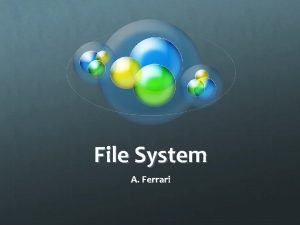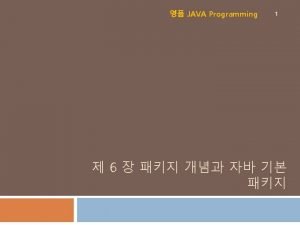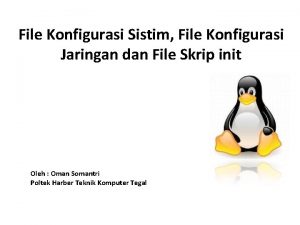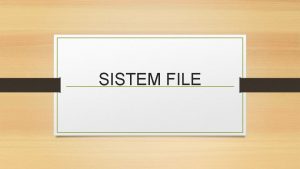File Management Chapter 12 1 File Management File















































































- Slides: 79

File Management Chapter 12 1

File Management File management system consists of system utility programs that run as privileged (kernel) application n For most applications n ¨ Input to applications is by means of a file ¨ Output is saved in a file for long-term storage ¨ Kbd and monitor can be regarded as “files” 2

IO (see ch 11) n In Unix-like systems all IO devices are made to look like files by the device driver ¨ See WS chapter 11 for details 3

File System Properties Long-term existence n Sharable between processes n Structure n 4

Terms Used with Files n Field ¨ Basic element of data ¨ Contains a single value. n EG avatar’s name or score ¨ Characterized n by its length and data type Record ¨ Collection of related fields ¨ Treated as a unit Example: player’s complete status record n All the data related to a software object n 5

Terms Used with Files (cont) n File ¨ Collection of similar records ¨ Treated as a single entity ¨ Have file names ¨ May restrict access n Database (specialized variant of files) ¨ Collection of related data ¨ Relationships exist among elements 6

Typical File Operations Create n Delete n Open n Close n Read n Write n 7

Typical Operations (records) Retrieve_All n Retrieve_One n Retrieve_Next n Retrieve_Previous n Insert_One n Delete_One n Update_One n Retrieve_Few n 8

File Management Systems The way a user of applications may access files n Programmer does not need to develop file management software n ¨ cf Assembly: Programmer is responsible for where it is stored, how much space, initializing, deleting, recovering space etc. 9

Objectives for a File Management System Meet the data management needs and requirements of the user n Guarantee that the data in the file are valid n Optimize performance n Provide I/O support for a variety of storage device types n 10

Objectives for a File Management System (cont) n Minimize or eliminate the potential for lost or damaged data ¨ Locking, journaling etc. Provide a standardized set of I/O interface routines n Provide I/O support for multiple users n 11

Minimal Set of Requirements User should be able to create, delete, read, write and modify own files n User may have controlled access to other users’ files n User may control what type of accesses are allowed to their own files n User should be able to restructure own files in a form appropriate to the problem n 12

Minimal Set of Requirements User should be able to move data between files n User should be able to back up and recover files in case of damage n User should be able to access files by using symbolic names n 13

USB, CD, etc… 14

Device Drivers Lowest level n Communicates directly with peripheral devices n Responsible for starting I/O operations on a device n Processes the completion of an I/O request n 15

Basic File System Physical I/O n Deals with exchanging blocks of data n Concerned with the placement of blocks n Concerned with buffering blocks in main memory n 16

Basic I/O Supervisor Responsible for file I/O initiation and termination n Control structures are maintained n Concerned with selection of the device on which file I/O is to be performed n Concerned with scheduling access to optimize performance n Part of the operating system n 17

Logical I/O Enables users and applications to access records n Provides general-purpose record I/O capability n Maintains basic data about file n 18

Access Method Reflect different file structures n Different ways to access and process data n 19

20

File Management Functions Identify and locate a selected file n Use directory to describe location of all files plus attributes n On a shared system, describe user access control n Blocking for access to files n Allocate files to free blocks n Manage free storage for available blocks n 21

Criteria for File Organization n Short access time ¨ Needed when accessing a single record ¨ Not needed for batch mode n Ease of update ¨ Not n needed for read-only media CD-ROM, DVD, Kbd etc. 22

Criteria for File Organization n Economy of storage ¨ Should be minimum redundancy in the data ¨ Redundancy can be used to speed access such as an index Simple maintenance n Reliability n 23

File Organization n The Pile ¨ Data are collected in the order they arrive ¨ Purpose is to accumulate a mass of data and save it ¨ Records may have different fields ¨ No structure ¨ Record access is by exhaustive search 24

Pile 25

File Organization n The Sequential File ¨ Fixed format used for records ¨ Records are the same length ¨ All fields the same (order and length) ¨ Field names and lengths are attributes of the file ¨ One field is the key field Uniquely identifies the record n Records are stored in key sequence n 26

File Organization n The Sequential File ¨ New records are placed in a log file or transaction file ¨ Batch update is performed to merge the log file with the master file 27

Sequential File 28

File Organization n Indexed Sequential File ¨ Index provides a lookup capability to quickly reach the vicinity of the desired record Contains key field and a pointer to the main file n Index is searched to find highest key value that is equal to or precedes the desired key value n Search continues in the main file at the location indicated by the pointer n 29

File Organization n Comparison of sequential and indexed sequential ¨ Example: a file contains 1 million records ¨ On average 500, 000 accesses are required to find a record in a sequential file ¨ If an index contains 1000 entries, it will take on average 500 accesses to find the key, followed by 500 accesses in the main file. Now average is 1000 accesses 30

File Organization n Indexed Sequential File ¨ New records are added to an overflow file ¨ Record in main file that precedes it is updated to contain a pointer to the new record ¨ The overflow is merged with the main file during a batch update ¨ Multiple indexes for the same key field can be set up to increase efficiency 31

Indexed Sequential File 32

File Organization n Indexed File ¨ Uses multiple indexes for different key fields ¨ May contain an exhaustive index that contains one entry for every record in the main file ¨ May contain a partial index ¨ Examples: Airline Reservations or Inventory Control 33

Indexed File 34

File Organization n The Direct or Hashed File ¨ Directly access a block at a known address ¨ Key field required for each record ¨ Features: rapid access, fixed length records, records accessed one at a time. ¨ Examples: Directories, pricing tables, schedules, name lists 35

36

File Directories n Contains information about files ¨ Attributes ¨ Location ¨ Ownership Directory itself is a file owned by the OS n Provides mapping between file names and files n 37

Simple Structure for a Directory List of entries, one for each file n Sequential file with the name of the file serving as the key n Provides no help in organizing the files n Forces user to be careful not to use the same name for two different files n 38

39

40

41

Two-level Scheme for a Directory n n One directory for each user and a master directory Master directory contains entry for each user ¨ Provides n n address and access control information Each user directory is a simple list of files for that user Still provides no help in structuring collections of files 42

Hierarchical, or Tree-Structured Directory Almost universally used n Master directory with user directories underneath it n Each user directory may have subdirectories and files as entries n 43

44

45

Hierarchical, or Tree-Structured Directory n Files can be located by following a path from the root, or master, directory down various branches ¨ This n is the pathname for the file Can have several files with the same file name as long as they have unique path names 46

Hierarchical, or Tree-Structured Directory Current directory is the working directory n Files are referenced relative to the working directory n OS services such as link and shortcuts obscure, but do not change, the directory structure n 47

File Sharing In multiuser system, allow files to be shared among users n Two issues n ¨ Access rights ¨ Management of simultaneous access 48

Access Rights n None ¨ User may not know of the existence of the file ¨ User is not allowed to read the user directory that includes the file n Knowledge ¨ User can only determine that the file exists and who its owner is 49

Access Rights n Execution ¨ The user can load and execute a program but cannot copy it n Reading ¨ The user can read the file for any purpose, including copying and execution n Appending ¨ The user can add data to the file but cannot modify or delete any of the file’s contents 50

Access Rights n Updating ¨ The user can modify, deleted, and add to the file’s data. This includes creating the file, rewriting it, and removing all or part of the data n Changing protection ¨ User can change access rights granted to other users n Deletion ¨ User can delete the file 51

Access Rights n Owners ¨ Has all rights previously listed ¨ May grant rights to others using the following classes of users n n Specific user User groups All for public files What rights must the sysadmin have? – Alternatively what rights does she not need to have? 52

Simultaneous Access User may lock entire file when it is to be updated n User may lock the individual records during the update n Mutual exclusion and deadlock are issues for shared access n 53

Fixed Blocking 54

Variable Blocking: Spanned 55

Variable Blocking Unspanned 56

Secondary Storage Management Space must be allocated to files n Must keep track of the space available for allocation n 57

Preallocation Need the maximum size for the file at the time of creation n Difficult to reliably estimate the maximum potential size of the file n Tend to overestimate file size so as not to run out of space n 58

Methods of File Allocation n Contiguous allocation ¨ Single set of blocks is allocated to a file at the time of creation ¨ Only a single entry in the file allocation table n n Starting block and length of the file External fragmentation will occur ¨ Need to perform compaction 59

60

61

Methods of File Allocation n Chained allocation ¨ Allocation on basis of individual block ¨ Each block contains a pointer to the next block in the chain ¨ Only single entry in the file allocation table n n Starting block and length of file No external fragmentation Best for sequential files No accommodation of the principle of locality 62

63

64

Methods of File Allocation n Indexed allocation ¨ File allocation table contains a separate onelevel index for each file ¨ The index has one entry for each portion allocated to the file ¨ The file allocation table contains block number for the index 65

66

67

UNIX File Management n Types of files ¨ Regular, or ordinary ¨ Directory ¨ Special ¨ Named pipes ¨ Links ¨ Symbolic links 68

Inodes Index node n Control structure that contains key information for a particular file n 69

70

71

72

Linux Virtual File System Uniform file system interface to user processes n Represents any conceivable file system’s general feature and behavior n Assumes files are objects that share basic properties regardless of the target file system n 73

74

75

Primary Objects in VFS n Superblock object ¨ Represents n Inode object ¨ Represents n a specific file Dentry object ¨ Represents n a specific mounted file system a specific directory entry File object ¨ Represents process an open file associated with a 76

Windows File System n Key features of NTFS ¨ Recoverability ¨ Security ¨ Large disks and large files ¨ Multiple data streams ¨ General indexing facility 77

NTFS Volume and File Structure n Sector ¨ The n Cluster ¨ One n smallest physical storage unit on the disk or more contiguous sectors Volume ¨ Logical partition on a disk 78

79
 File-file yang dibuat oleh user pada jenis file di linux
File-file yang dibuat oleh user pada jenis file di linux Physical image vs logical image
Physical image vs logical image Fungsi sistem file
Fungsi sistem file Remote file access in distributed file system
Remote file access in distributed file system What does a markup tag tells the web browser
What does a markup tag tells the web browser In a file-oriented information system, a transaction file
In a file-oriented information system, a transaction file Php file
Php file Enter.php?chapter=
Enter.php?chapter= File.php?n=
File.php?n= Operations management chapter 12 inventory management
Operations management chapter 12 inventory management Computer operating system worksheets
Computer operating system worksheets What are the main components of file management
What are the main components of file management Eoffice implementation handbook
Eoffice implementation handbook Project file management ansys
Project file management ansys Objective of file management system
Objective of file management system File management in android operating system
File management in android operating system Module 4 operating systems and file management
Module 4 operating systems and file management File management in c
File management in c Electronic file management
Electronic file management 3 importance of file management
3 importance of file management Objectives of file management system
Objectives of file management system Getw and putw in c
Getw and putw in c Scientific management
Scientific management Top management middle management first line management
Top management middle management first line management Middle level management
Middle level management The red tent summary chapter by chapter
The red tent summary chapter by chapter Chapter 8 summary of the great gatsby
Chapter 8 summary of the great gatsby Chapter 10 chemical reactions
Chapter 10 chemical reactions Chapter 11 assessment chemistry
Chapter 11 assessment chemistry Chapter 9 chemical reactions answers
Chapter 9 chemical reactions answers Means and extremes of proportions
Means and extremes of proportions Chapter 6 career readiness chapter review answers
Chapter 6 career readiness chapter review answers 7 ionic and metallic bonding
7 ionic and metallic bonding Chapter 9 surface water chapter assessment answer key
Chapter 9 surface water chapter assessment answer key Chapter 2 assessment physics answers
Chapter 2 assessment physics answers Chemistry the central science 14th edition
Chemistry the central science 14th edition Chapter 7 ionic and metallic bonding answer key
Chapter 7 ionic and metallic bonding answer key Population ecology section 1 population dynamics answer key
Population ecology section 1 population dynamics answer key Chapter 2 chapter assessment
Chapter 2 chapter assessment Book of philippians background
Book of philippians background Ionic compounds properties
Ionic compounds properties Chapter 7 chapter assessment ionic compounds and metals
Chapter 7 chapter assessment ionic compounds and metals Dichlorine octoxide formula
Dichlorine octoxide formula Process of strategic cost management
Process of strategic cost management Chapter 3 project management
Chapter 3 project management Introduction to management chapter 1 notes
Introduction to management chapter 1 notes Operation management chapter 3
Operation management chapter 3 Operations management chapter 4 forecasting solutions
Operations management chapter 4 forecasting solutions Chapter 2 operations management
Chapter 2 operations management Mastering strategic management
Mastering strategic management Strategic management chapter 5
Strategic management chapter 5 Strategic management chapter 4
Strategic management chapter 4 What is new marketing realities
What is new marketing realities Chapter 9 management of quality
Chapter 9 management of quality Management information system chapter 2
Management information system chapter 2 Mis chapter 3
Mis chapter 3 Management information system chapter 4
Management information system chapter 4 Management information system chapter 1
Management information system chapter 1 The great divide supply chain management
The great divide supply chain management Introduction to operations management
Introduction to operations management Introduction to management science solution
Introduction to management science solution Chapter 2 human resource management
Chapter 2 human resource management Chapter 9 human resources management
Chapter 9 human resources management Chapter 4 job analysis and the talent management process
Chapter 4 job analysis and the talent management process Characteristics of strategic management
Characteristics of strategic management A series of coordinated related multiple projects
A series of coordinated related multiple projects Chapter 9 strategic management
Chapter 9 strategic management Chapter 9 information management and security
Chapter 9 information management and security Financial management chapter 8 risk and return
Financial management chapter 8 risk and return Potential appraisal
Potential appraisal Chapter 8 leadership in management
Chapter 8 leadership in management Chapter 7 strategic management
Chapter 7 strategic management Chapter 7 nursing management of pain during labor and birth
Chapter 7 nursing management of pain during labor and birth Chapter 7 management and leadership
Chapter 7 management and leadership Management issues central to strategy implementation
Management issues central to strategy implementation Implementing strategies: management and operations issues
Implementing strategies: management and operations issues Chapter 7 business management
Chapter 7 business management Chapter 6 understanding the management process
Chapter 6 understanding the management process Understanding the management process
Understanding the management process What are the two external dimensions of the space matrix?
What are the two external dimensions of the space matrix?






